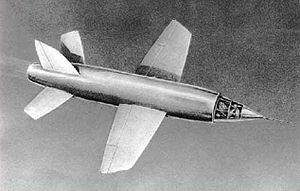R.A.E. – Vickers Transonic Research Rocket: Difference between revisions
←Created page with '<!-- This article is a part of Wikipedia:WikiProject Aircraft. Please see Wikipedia:WikiProject Aircraft/page content for recommended layout. --> {|{{Infobo...' |
(No difference)
|
Revision as of 20:47, 8 October 2009
| R.A.E.- Vickers Transonic Research Rocket | |
|---|---|

| |
| Artist's impression of the Miles M.52 | |
| Role | Experimental supersonic aircraft |
| National origin | United Kingdom |
| Manufacturer | Royal Aircraft Establishment & Vickers-Armstrong Ltd |
| Designer | Don L. Brown |
| Status | Cancelled |
| Number built | 3 complete craft |
| Developed from | <!—Miles M.52 design --> |
The Miles M.52 was a British supersonic research aircraft project which was undertaken in top secret between 1942 and 1945 to Ministry of Supply specification E.24/43. The project was cancelled because the Government of the day was persuaded that with the accumulation of data it was felt that the E.24/43 aircraft was unlikely to reach sonic speed. Wind-tunnel model tests apparently indicated serious loss of longitudinal stability at high subsonic speed as was then characteristic of existing aircraft. The decision was reached to acquire preliminary experience of flight under transonic conditions using rocket-driven pilotless scale models.
Development
A contract was placed in 1945 with Vickers Armstrong Limited for the design and construction of several test vehicles. Early in 1946 the contract for the E.24/43 was cancelled, since it was felt impossible to ensure the safe escape for the pilot in the event of an emergency ejection at high speed. The difficulties surrounding flight at sonic speeds appeared to increase with increasing knowledge. In those circumstances consideration of an improved version of the E.24/43 was discarded in favour of pilotless models which for the initial try-out were to be 3/10-scale versions of the Miles M.52 design. For drag and stressing reasons the operational altitude had to be in the stratosphere to which altitude the test vehicles would be carried by a parent aircraft, a De havilland Mosquito

Power plant
The design was to be powered by …………………..
Design
The test vehicle was a 3/10-scale model of the Miles E.24/43 design (except for ~he omission of the distinctive annular air intake of the full-scale aircraft). To maintain the center of gravity (c.g.) it was necessary to include a large balance weight (a!most 1/10th of total all-up weight) in the foremost section of the nose. The layout was further restricted by the need to maintain a constant c.g. position during the consumption of the fuels. This was achieved by placing ahead of the wing a small tank holding one-third of the total oxidant (as well as the fuel in the shaped nose tank) and locating the main oxidant tank aft of tile wing. Other large components were placed fore-and-aft of the wing. In the space below and above the wing centre section were located the air, fuel, oxidant and warm-air pipes, telemetering transmitter, instruments and batteries as well as the auto-pilot, timing clock, wiring terminal fuses and the connections by which the test vehicle was carried on the parent aircraft. The rear section housed the combustion chamber, radar transponder, smoke-producing fluid, instruments and oscillators for combustion chamber pressure and tailplane angle, servos and dive mechanism for the tailplane which together with the fixed directional fin were fitted to the lower body prior. The. single-piece wing was of mahogany with Dural inserts at the leading and trailing edges; it was of biconvex section and of tapered plan form with an unswept half-chord line. The Dural inserts formed a convenient dipole-aerial system for the telemetering unit. (A similar arrangement on the tailplane served the radar transponder.)
Operational history
A1: On the last check flight before live firing the parent aircraft descended into a storm at 22,000 ft. When smooth conditions were regained at about 8,000 ft altitude the test vehicle A1 carrying all the prototype examples of instruments and equipment was found to have parted from the aircraft and to have disappeared beneath the waters of the Bristol Channel.
Test zone
Subsequent work
Specifications
Data from [1]
General characteristics
- Crew: 1
Performance
See also
Aircraft of comparable role, configuration, and era
References
- Notes
- ^ Brown 1980, p. 40.
- Bibliography
- Brown, Don Lambert. Miles Aircraft Since 1925. London: Putnam & Company Ltd., 1970. ISBN 0-37000-127-3.
- Brown, Eric. "Miles M.52: The Supersonic Dream." Air Enthusiast Thirteen, August-November 1980. ISSN 01443-5450.
